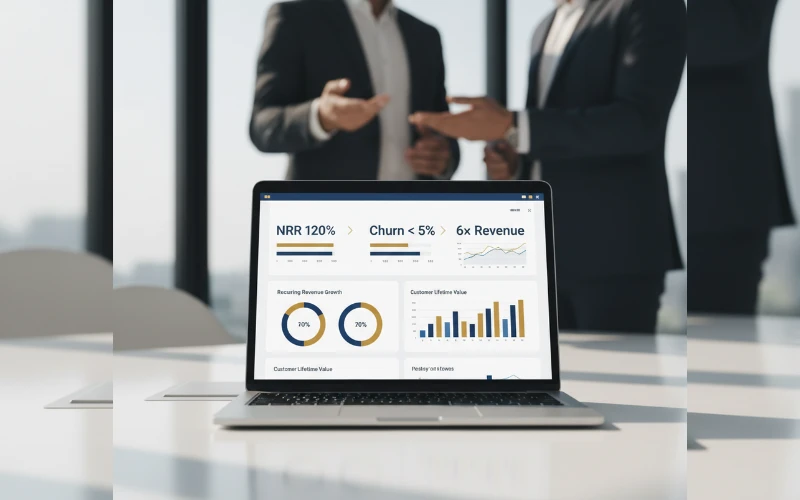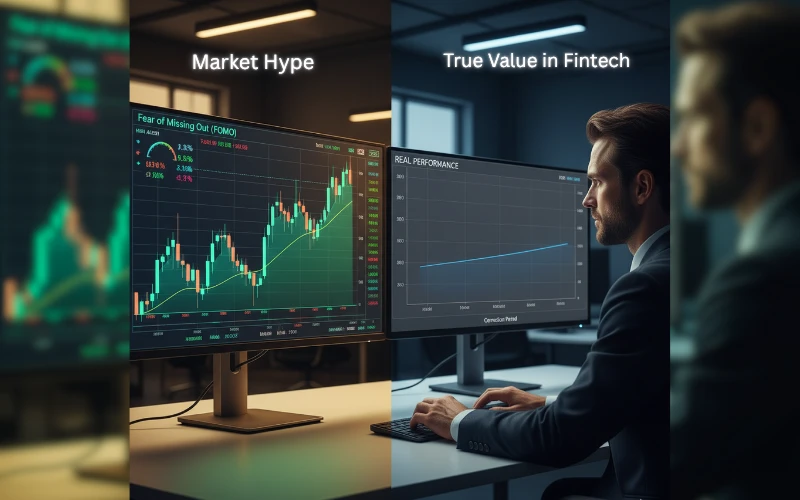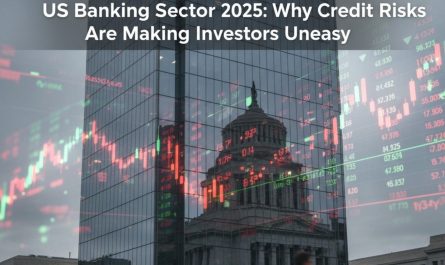Six times annual revenue.
That’s the price many private fintech companies in North America are commanding today — and buyers are still competing to pay it.
At first glance, that sounds irrational in a market still digesting higher interest rates, slower growth, and tighter capital. But if you’ve been watching the fintech M&A landscape closely, you’ll notice something interesting: the right companies — those with predictable revenue, strong compliance foundations, and real infrastructure value — are defying gravity.
Over the past 18 months, we’ve seen a wave of acquisitions where private fintechs are being valued like mature software businesses rather than financial intermediaries. Payment platforms, compliance tech firms, and embedded finance enablers are closing deals at valuations that were once reserved for venture-backed SaaS leaders.
So, what’s really driving these record multiples?
Why are sellers exiting now, even as public markets price caution into everything else?
And perhaps most importantly — can these valuations survive if interest rate cuts stall or regulatory scrutiny tightens heading into 2026?
In this article, I’ll break down what’s behind the 6× revenue phenomenon — from the underlying deal logic and buyer psychology to the segments still commanding premiums — and share what these trends reveal about the future of fintech consolidation.
The Drivers Behind These Record-High Multiples
If you look past the headlines, the 6× revenue trend isn’t just market hype. It’s the outcome of four clear forces shaping private fintech deals today.
Let’s break them down.
1. The Recurring Revenue Obsession
Buyers aren’t just chasing growth — they’re paying for predictability.
Fintechs with recurring or transaction-linked revenue models are now treated like SaaS businesses, not financial middlemen.
Companies showing Net Revenue Retention (NRR) above 120% and churn below 5% command premium pricing because their income is steady, visible, and scalable.

Recurring income from things like payment processing, subscription APIs, or compliance platforms gives acquirers confidence that the revenue will stick long after the founders leave.
According to the KPMG Pulse of Fintech: H2 2024, global fintech valuations have increasingly favored recurring revenue models and regulated infrastructure firms—showing investors’ clear shift toward profitability and predictability.
2. The Scarcity Premium
There aren’t many fintechs with both profitability and clean compliance records — and that scarcity drives bidding wars.
Large financial players and private equity firms are flush with cash but selective. They’re buying the few companies that already have the regulatory frameworks, licenses, and risk management systems in place.

When only a handful of acquisition-ready fintechs exist in each vertical, prices naturally rise. The Bain Global M&A Report 2025 highlights this “flight to quality” trend, noting that investors are increasingly prioritizing proven profitability and regulatory strength over high-growth narratives.
3. Margin and Scalability
High margins are another reason fintech valuations resemble software companies.
Many infrastructure-driven fintechs — like fraud detection tools, KYC/AML automation, or embedded payments APIs — now run at 70%+ gross margins, similar to SaaS benchmarks.
That’s why buyers see these deals as long-term compounding machines, not short-term experiments.
The more scalable the tech and the more automated the compliance, the higher the multiple.
4. FOMO and Strategic Expansion
Finally, there’s a strong fear of missing out (FOMO) among both banks and private equity roll-ups.

After years of watching startups disrupt payments, compliance, and lending, traditional players now want to own the technology instead of partnering with it.
That urgency pushes them to pay up for reliable, proven products that can integrate quickly.
Or as one banker recently put it:
“We’re seeing buyers pay more for predictability than growth. In fintech M&A, reliable revenue beats rapid scaling every time.”
In short :
The current fintech M&A wave isn’t built on hype — it’s built on recurring cash flow, scarcity, scalability, and strategy.
Why Sellers Are Exiting Now
While buyers are chasing strategic value, sellers have their own logic — and it’s just as practical.
If you’re a fintech founder in 2025, you’re facing a complex mix of opportunity and pressure: valuations are high, but so are compliance costs, funding risks, and regulatory scrutiny.
Here’s what’s pushing many founders toward the exit button.
1. Regulatory Fatigue
The fintech regulatory landscape has become exhausting.
From CFPB investigations to Banking-as-a-Service (BaaS) partner crackdowns, compliance expectations have soared.
Founders who once thrived on speed now face ongoing audits, AML testing, and data-protection reviews.
Selling to a larger, licensed institution often feels like a safer way to scale.
The CB Insights State of Fintech Q2 2025 Report shows that global fintech funding has steadied around $10.5 billion per quarter — a sign of market maturity rather than exuberance.
2. Liquidity Timing
After the 2020–2021 bull cycle, many early investors are reaching the end of their holding period.
High valuations in 2024–2025 give them the perfect window to cash out before the next rate or policy shift.
In other words — they’re selling into strength.
3. Slower Funding Environment
Venture capital funding in fintech has cooled since mid-2022.
Raising another round means accepting lower valuations or stricter investor terms.
For many founders, selling to a strategic buyer feels smarter than enduring a “down round.”
4. Strategic Fit
Finally, many founders sell because they find a buyer who can amplify their product’s reach.
Joining a large network or infrastructure platform allows them to grow faster than they could independently.
| Seller Motivation | Reason |
| Regulatory fatigue | Growing compliance load (KYC/AML/BaaS risk) |
| Liquidity timing | High valuations = exit opportunity |
| Slower funding | VC pullback since 2022 |
| Strategic fit | Buyers offer faster scale-up |
Fintech founders aren’t just selling for the money — they’re selling for momentum and survival.
They see consolidation not as an exit from innovation, but as the next logical phase of fintech’s evolution.
Are Buyers Paying for Real Value—or Just Market Hype?
Let’s be honest — not every fintech selling for 6× revenue deserves it.
A recurring revenue model sounds solid, but recurring ≠ guaranteed.
Many “usage-based” fintechs depend on one or two sponsor banks or payment processors for the majority of their revenue. When those partners change terms or switch vendors, that so-called “predictable” income can vanish overnight.

In reality, buyers today are paying premiums for durable revenue, not just recurring invoices. That means digging into cohort stability, gross margins, and customer concentration before signing any deal.
According to benchmarks from industry data, healthy fintechs typically show Net Revenue Retention (NRR) between 110–130% and gross margins in the 65–75% range — metrics that justify premium pricing because they resemble SaaS-level resilience.
As highlighted in the KPMG Pulse of Fintech: H2 2024, buyers are rewarding fintechs that combine margin strength, retention consistency, and compliance readiness — not just growth curves.
“Premiums are justified where margin, retention, and compliance align. Else, it’s optimism priced as certainty.”
The New Reality of Fintech Due Diligence
Five years ago, buyers asked for ARR and CAC.
Now, they’re asking for AML reports, data lineage maps, and cyber risk assessments.
The fintech M&A process has become longer, more technical, and far more regulated.
Typical timelines have stretched by 4–8 weeks compared to pre-2022 norms, largely because of added scrutiny around:
- BSA/AML and KYC compliance (especially in BaaS or neobank deals)
- Data privacy and third-party risk management
- Model validation and cloud security audits
- Cyber diligence — now a deal-breaking step in many transactions

According to Aon’s 2024 Risk in Review Report, nearly half of dealmakers expect longer due diligence cycles as cyber, data, and regulatory risks reshape the M&A process — signaling a shift from “speed to close” toward “certainty of close.”
“In 2020, buyers asked for ARR and CAC. In 2025, they’re asking for AML reports and data lineage maps.”
The Segments Still Commanding Premium Valuations
Even within fintech, not all sectors are treated equally anymore.
Some categories are earning their multiples, while others are cooling down fast.
Here’s how the market looks today :
| Segment | Outlook | Rationale |
| Payments Infrastructure | Premium | Mission-critical rails with high recurring transaction volume. |
| Fraud & Risk Tech | Premium | Post-regulation surge in demand; essential for compliance and AI fraud prevention. |
| RegTech / Compliance Tools | Strong | Directly monetizes trust, auditability, and transparency. |
| Wealth & Trading Platforms | Normalizing | Fee compression, slowing user growth, and high CAC. |
| Consumer Lending / BNPL | Weakening | Rising defaults, margin pressure, and tighter regulatory oversight. |
The CB Insights State of Fintech Q2 2025 Report confirms that payments and RegTech firms continue to attract the bulk of late-stage M&A interest.
Additionally, McKinsey’s Global Payments Report 2024 reinforces that payment infrastructure and compliance automation remain the top-performing verticals in both deal count and value.
The 2026 Outlook — Can These Multiples Hold ?
So, will these record fintech valuations still make sense a year from now?
That depends on two forces: interest rates and regulation.
If the Federal Reserve delays or reverses rate cuts, the cost of capital will stay high — meaning valuations could compress by 1–2x in 2026. When money isn’t cheap, buyers become selective, and “growth at any cost” no longer flies.
At the same time, regulatory tightening — from the CFPB and OCC — will continue to filter out weaker players. The OCC’s 2025–2026 Fintech Roadmap already outlines stricter guidance for BaaS (Banking-as-a-Service) and third-party risk management, signaling a tougher environment for lightly regulated fintechs.
Cyber risks and AI-related threats are also reshaping how deals are structured. Expect more RWI (Representations and Warranties Insurance) carve-outs, holdbacks, and security-focused due diligence to become standard practice.
According to Federal Reserve projections for 2025–2026, policymakers anticipate gradual easing, but uncertainty around inflation and labor markets could keep rates elevated longer than expected.
Still, the “flight to quality” isn’t going anywhere.
Fintechs with strong compliance, diversified revenue, and real unit economics will continue to command premium valuations — even if headline multiples normalize.
“Healthy consolidation isn’t the end of fintech innovation — it’s proof that the industry is maturing.”
From Hype-Driven to Performance-Priced
After watching fintech M&A evolve over the past few years, one truth stands out: premium pricing now rewards fundamentals, not flash.
The days of selling a “growth story” are fading fast.
Today’s acquirers are data-driven — they value recurring revenue, compliance readiness, and margin durability over vanity metrics.
Sellers, meanwhile, are adapting to a smarter market — one where the ability to show real, predictable performance outweighs any funding hype from the past decade.
The future of fintech isn’t about inflated multiples; it’s about clarity, resilience, and trust.
Markets are simply learning to price what truly lasts.
“When I look at today’s 6× deals, I don’t see irrational exuberance — I see a market finally learning to price what truly lasts.”
Disclaimer
This article is intended for informational and analytical purposes only. It does not constitute financial, investment, or legal advice. The insights and data referenced are based on publicly available reports and industry research at the time of writing. Readers should perform their own due diligence before making any business or investment decisions related to fintech mergers or acquisitions.
Contents
- 1 The Drivers Behind These Record-High Multiples
- 2 1. The Recurring Revenue Obsession
- 3 2. The Scarcity Premium
- 4 3. Margin and Scalability
- 5 4. FOMO and Strategic Expansion
- 6 In short :
- 7 Why Sellers Are Exiting Now
- 8 1. Regulatory Fatigue
- 9 2. Liquidity Timing
- 10 3. Slower Funding Environment
- 11 4. Strategic Fit
- 12 Are Buyers Paying for Real Value—or Just Market Hype?
- 13 The New Reality of Fintech Due Diligence
- 14 The Segments Still Commanding Premium Valuations
- 15 The 2026 Outlook — Can These Multiples Hold ?
- 16 From Hype-Driven to Performance-Priced
- 17 Disclaimer

